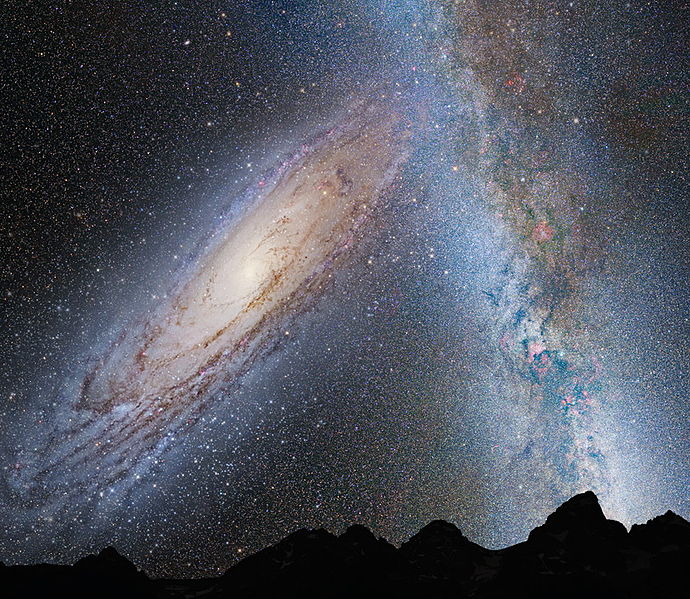આપણા ઘરની રચના આકાશગંગા Milky Way began 12 billion years ago. Since then, it has undergone a sequence of mergers with other galaxies and grew in mass and size. The remnants of building blocks (i.e., galaxies that merged with the Miky Way in the past) can be identified through their unusual values for energy and angular momentum and low metallicity. The two earliest building blocks of our home આકાશગંગા have recently been identified using Gaia dataset and have been named Shiva and Shakti after Hindu deities. Gaia જગ્યા telescope which is dedicated to the study of our home galaxy has revolutionised the study of Milky Way. Gaia Enceladus/ Sausage stream, the Pontus stream and the “poor old heart” of the Milky Way were identified earlier using Gaia dataset. The history of Milky Way is replete with mergers. હબલ જગ્યા Telescope images suggest that six billion years from now, our home galaxy will merge with the neighbouring Andromeda galaxy.
Galaxies and other large structures formed in the બ્રહ્માંડ about 500 million years after the Big Bang.
આપણા ઘરની રચના આકાશગંગા આકાશગંગા લગભગ 12 અબજ વર્ષો પહેલા શરૂ થઈ હતી. ત્યારથી, તે અન્ય તારાવિશ્વો સાથે વિલીનીકરણના ક્રમમાંથી પસાર થઈ છે જેણે તેના સમૂહ અને કદમાં વૃદ્ધિમાં ફાળો આપ્યો છે. આકાશગંગાનો ઇતિહાસ અનિવાર્યપણે આપણી ઘરગથ્થુ આકાશગંગા સાથે અન્ય તારાવિશ્વોના વિલીનીકરણનો ઇતિહાસ છે.
The basic properties of the તારાઓ like energy and angular momentum are directly linked to the speed and direction of the આકાશગંગા of origin and are shared between the stars of the same galaxy. When galaxies merge, energy and angular momentum remain conserved over time. This serves as a key tool in identification of a merger remnant. A large group of તારાઓ with similar unusual values of energy and angular momentum are likely to be a merger remnant of a galaxy. Also, the older stars have low metallicity, i.e., stars that formed earlier have low metal contents. Based on these two criteria, it is possible to trace merger history of the Milky Way however it would not have been possible without the Gaia datasets.
Launched by ESA on 19 December 2013, Gaia જગ્યા telescope is dedicated to the study of Milky Way including its origin, structure and evolutionary history. Parked in Lissajous ભ્રમણકક્ષા around L2 Lagrange point (located approximately 1.5 million km from Earth in the direction opposite the Sun) along JWST and Euclid spacecrafts, Gaia probe is conducting a huge stellar census covering about 1.5 billion stars in the Milky Way recording their motions, luminosity, temperature and composition and creating a precise 3D map of the home આકાશગંગા. Hence, Gaia is also referred as billion-star surveyor. The datasets generated by Gaia has revolutionized study of history Milky Way.
In 2021, using Gaia datasets, astronomers learnt of a major merger and identified Gaia Enceladus/Sausage stream, the remnant of Gaia-Sausage-Enceladus (GSE) આકાશગંગા that merged with the Milky Way between 8 and 11 billion years ago. Subsequently, Pontus stream and “poor old heart” of the Milky Way were identified the following year. The Pontus stream is the remnant of Pontus merger while “poor old heart” is સ્ટાર group that formed during the initial mergers that created the proto-Milky Way and continue to reside in the central region of Milky Way.
Now, astronomers report discovery of two streams of તારાઓ that formed and merged with an early version of our Milky Way between 12 and 13 billion years ago, around the time when galaxies were forming in the early બ્રહ્માંડ. For this, the researchers combined Gaia data with detailed stellar spectra from the સ્લોન ડિજિટલ સ્કાય સર્વે (DR17) and observed that stars were crowded around two specific combinations of energy and angular momentum for a certain range of low-metal stars. The two groups had angular momentum similar to the stars that had been part of separate galaxies which merged with the Milky Way. Perhaps, the earliest building blocks of the Milky Way, the researchers have named them Shiva and Shakti after the Hindu deities. It is possible that the newly discovered star groups were first to merge with the ‘poor old heart’ of our Milky Way and the story towards a large આકાશગંગા began. Future studies should confirm if Shiva and Shakti are indeed part of prehistory of Milky Way.
ભવિષ્યમાં આપણા ઘરની આકાશગંગાનું શું થશે?
Evolutionary history of Milky Way is replete with mergers. હબલ જગ્યા Telescope images suggests that six billion years from now, our home galaxy will merge with the neighbouring Andromeda galaxy situated at 2.5 million light-years away to give rise to a new galaxy. Andromeda will collide with the Milky Way at 250,000 mph about 4 billion years from now. The clash between the two galaxies will last for 2 billion years giving rise to a combined elliptical galaxy.
The solar system and the Earth will survive but will have new coordinates in જગ્યા.
***
સંદર્ભ:
- નાયડુ આરપી, એટ અલ 2021. H3 સર્વે સાથે આકાશગંગાના છેલ્લા મુખ્ય વિલીનીકરણનું પુનઃનિર્માણ. ધ એસ્ટ્રોફિઝિકલ જર્નલ, વોલ્યુમ 923, નંબર 1. DOI: https://doi.org/10.3847/1538-4357/ac2d2d
- મલ્હાન કે., એટ અલ 2022. આકાશગંગાના વિલીનીકરણના વૈશ્વિક ગતિશીલ એટલાસ: ગ્લોબ્યુલર ક્લસ્ટરો, તારાઓની પ્રવાહો અને ઉપગ્રહ તારાવિશ્વોની ગૈયા EDR3-આધારિત ભ્રમણકક્ષાના અવરોધો. 17 ફેબ્રુઆરી 2022 ના રોજ પ્રકાશિત. ધ એસ્ટ્રોફિઝિકલ જર્નલ, વોલ્યુમ 926, નંબર 2. DOI: https://doi.org/10.3847/1538-4357/ac4d2a
- મલ્હાન કે., અને રિક્સ એચ.-ડબલ્યુ., 2024. 'શિવ અને શક્તિ: આંતરિક આકાશગંગામાં પ્રોટો-ગેલેક્ટિક ફ્રેગમેન્ટ્સ. ધ એસ્ટ્રોફિઝિકલ જર્નલ. 21 માર્ચ 2024 ના રોજ પ્રકાશિત. DOI: https://doi.org/10.3847/1538-4357/ad1885
- મેક્સ પ્લેન્ક ઇન્સ્ટિટ્યૂટ ફોર એસ્ટ્રોનોમી (MPIA). સમાચાર – સંશોધકો આકાશગંગાના બે સૌથી જૂના બિલ્ડીંગ બ્લોકની ઓળખ કરે છે. પર ઉપલબ્ધ છે https://www.mpia.de/news/science/2024-05-shakti-shiva?c=5313826
- શિઆવી આર. ઇt al 2021. એન્ડ્રોમેડા ગેલેક્સી સાથે આકાશગંગાનું ભાવિ વિલીનીકરણ અને તેમના સુપરમાસીવ બ્લેક હોલનું ભાવિ. arXiv પર પ્રીપ્રિન્ટ કરો. DOI: https://doi.org/10.48550/arXiv.2102.10938
***






































